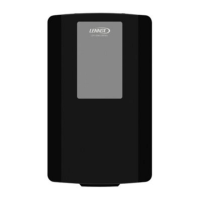Page 15
Dip Switch Settings
# ZONES TO STAGE: If staging
thermostats are not installed with
the system, second stage (does
not apply to auxiliary heat on heat
pump applications) operation can be initiated when
more than one zone is calling for conditioning. Four
selections are available: one, two, three and four zones.
Set to one, thermostat inputs or timed length of call
control staging, for all other settings only the specified
number of calling zones can trigger staging.
SWITCHES ARE SHOWN AS BLACK.
DAS SENSOR CL-45/40: This
switch controls the temperature
at which the cooling equipment
will cut out to prevent freezing
the indoor coil. For a low limit temperature of 45°F,
leave the switch in the ON position (45). For a low limit
temperature of 40°F, move the switch to the OFF
position (CL-40).
The panel factory default is 45. Do not set this limit to
40 unless equipment issues develop requiring a lower
temperature.
DAS SENSOR HT-140/160: This switch controls the
temperature at which the heating equipment will cut out
to prevent overheating. Set the high limit temperature that
is appropriate for the equipment being used. The factory
default is 160, use this option for gas heat. When using
heat pumps and electric heat, set this switch to 140. For
a high limit temperature of 140°F, move the switch to
the ON position (140). For a high limit temperature of
160°F, leave the switch in the OFF position (HT-160).
IMPORTANT: The discharge air temperature sensor
is required. If a short or open circuit is detected
between the Discharge Air Sensor (DAS) terminals,
the control panel will only respond to Zone 1 and the
dampers will not close.
STAGE MINUTES: If staging
thermostats are not installed and
the # Zones to Stage is set to 1,
staging can be controlled by the
amount of time that any one zone must be calling for
conditioning before initiating a second stage of heating
or cooling (heat/cool systems) or second stage
compressor (heat pump systems). Four selections are
available: 0, 10, 30 and 60 minutes. Set to zero,
thermostat inputs or “# of Zones Calling” control
staging. SWITCHES ARE SHOWN AS BLACK.
AUX. MINUTES: With the control
panel configured for ZONE 1
operation, auxiliary heat can only
be controlled by time. Configured
for ANY ZONE operation, auxiliary heat can be
controlled by time or by individual thermostats. For
thermostat control of auxiliary heat, set all AUX.
MINUTES switches to the OFF position and refer to the
sequence of operation sections on the following pages
for details. For timed control, set the AUX. MINUTES
switches to the amount of time the first and second
stage (where applicable) compressors are allowed to try
and satisfy a call for heating before auxiliary heat will be
activated. There are four selections available: 0, 10, 30
and 60 minutes. Set to zero, auxiliary heat can be
controlled by the thermostat only. SWITCHES ARE
SHOWN AS BLACK.
ZONE 1/ANY ZONE: This
switch determines how the
control panel will control the
mode of operation. In the
ZONE 1 configuration, Zone
1 sets the mode of operation through the use of the O
and B thermostat inputs. When the Zone 1 O terminal is
energized, the system is in the cool mode and only cool
calls will be satisfied. When the Zone 1 B terminal is
energized, the system is in heat mode and only heat
calls will be satisfied. If neither the Zone 1 O nor B
terminal is energized, the system will not respond to
cool or heat calls, but fan operation is unaffected. This
configuration offers restricted control and is likely to be
used in applications where mode control from Zone 1
is desired. In the ANY ZONE configuration, the control
panel responds to
each individual thermostat equally.
One zone can call for cooling and another zone can call
for heat. The system will respond to both needs,
although it can not heat and cool at the same time. This
offers control
flexibility and is likely to be used in
applications where the heating and cooling needs of the
zones are completely independent. TALK WITH THE
CUSTOMER TO DETERMINE WHICH CONTROL
CONFIGURATION SHOULD BE USED. Refer to the
Sequence of Operation section on the following pages
for additional details.
Factory Settings
Factory Settings
Factory Settings
Factory Settings
Factory Settings

